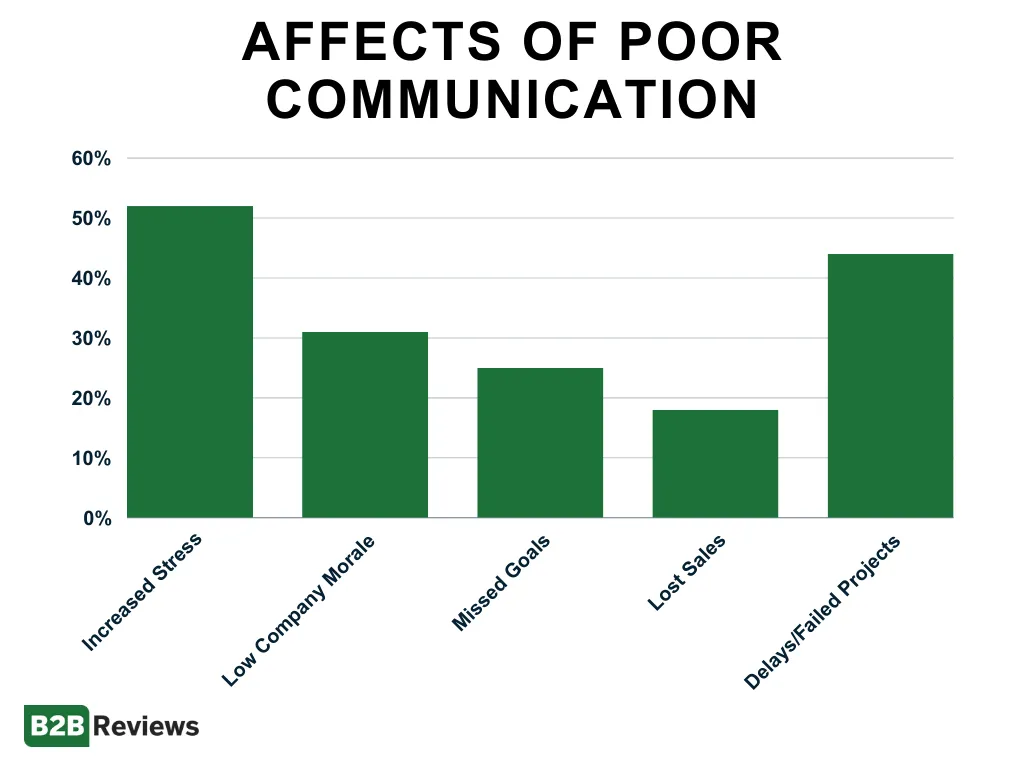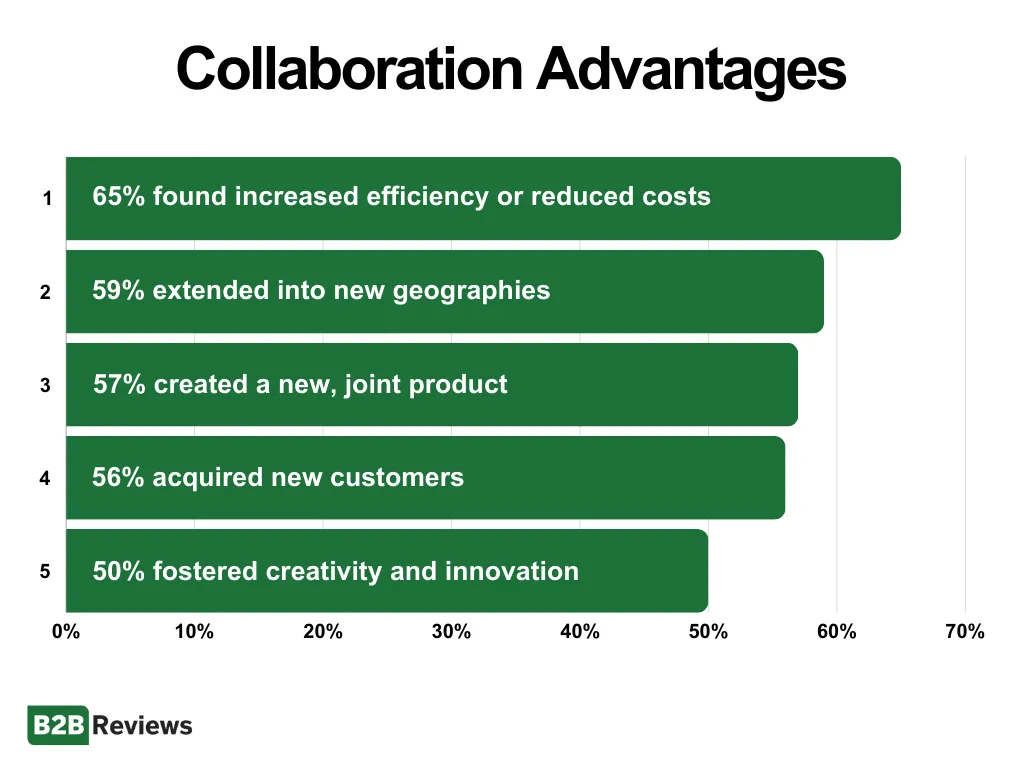We may earn money when you click on links to our partners. Advertiser Disclosure
Teamwork is vital in all aspects of life, but it’s especially important in the workplace. A successful business is not run on the shoulders of a single person but rather the combined efforts of teams. That’s where workplace collaboration comes in.
Business leaders who value and actively promote teamwork soon see the many benefits it brings. Employees are happier and more productive, revenue increases, and turnover rate decreases. Below, we break down the most recent statistics on workplace collaboration to demonstrate its importance and how it benefits your business.
Key Takeaways
- 73% of employees do better work when collaborating.
- 99.1% of workers want to work for an organization that nourishes honest communication.
- Business leaders see 30% higher productivity in collaborative workplaces.
- Employees show 41% lower absenteeism after higher engagement.
- Good teamwork leads to 21% higher profitability.
HR Statistics
Collaboration in the workplace brings a myriad of benefits. When employees can confidently work together towards a common goal, productivity and innovation skyrocket.
- 73% of employees do better work when collaborating.
- 60% of employees are more innovative in a collaborative environment
- 99.1% of workers want to work for an organization that nourishes honest communication.
Good teamwork in the workplace also improves overall satisfaction. When asked, 17% of workers said they felt more satisfied with their jobs when collaborating with their coworkers.
With over half of American jobs requiring some form of teamwork, it is no surprise that 75% of employers think teamwork and collaboration are “very important.” A big aspect of collaboration is communication.
- Despite this, only 18% of employees receive communication evaluations during their performance reviews.
- Additionally, 39% of employees believe their company lacks collaboration.
- However, 41% of workers who know their strengths show lower absenteeism.
Communication and collaboration not only help employees better understand their performance and roles in the company, but they also help motivate employees to continue showing up to work and doing a good job. This will, in turn, benefit your business.
- You can increase profits by 29% by recognizing your teams’ quality work and achievements.
Most jobs do not exist in a vacuum. Most jobs function in tandem, informing and affecting each other. As such, knowledge workers need to communicate with others to complete their jobs correctly and efficiently.
- 14% of working hours are spent communicating and collaborating with others.
Collaboration can be accomplished in many different ways. In an age of technology, online tools are becoming a key method of communication and collaboration. In fact, 92% of employees believe that mobile phones are vital to good communication and cooperation.
- Online collaboration tools scale up productivity by 30%.
- 83% of employees use technology to collaborate.
- 81% of workers feel positively towards peer collaboration apps.
- However, 59% of workers view online collaboration tools as challenging.
Despite the challenges, 37% of employees believe that teamwork is essential and builds connection, influencing their decisions to remain with the company. If you can cultivate an environment where employees can help each other and overcome the challenges of online tools, you will see employee satisfaction and productivity increase.
The use of social tools for collaboration will likely increase as time goes on. Millennials, who currently make up the majority of the workforce, advocate for online tools as a means of teamwork.
- 49% of Millennials support online collaboration tools.
- 40% of Gen Xs feel positively towards these tools.
- 31% of Baby Boomers feel positive about these online tools.
Teamwork in the workplace is essential. As a business owner, you want to feel confident in your employees’ ability to brainstorm and problem-solve. Online tools are one way to help streamline communication and reap the benefits of collaboratio
Benefits of Collaboration for Employees
When employees work together, they’re able to work more efficiently and enjoy the benefits of a cooperative environment.
Businesses that foster collaborative work will see their employees feeling more engaged, productive, and effective. The International Data Corporation (IDC) predicts businesses will see:
- 30% lower staff turnover.
- 30% higher productivity.
- 30% higher revenue per employee.
One study found that the majority of U.S. employees are “matrixed” in one way or another. “Matrixed” means that they work on multiple teams daily, reporting to the same or different managers.
- 84% of American employees work on multiple teams daily.
When employees get to work with a great team, it improves employee retention. In fact, a recent survey found that 47% of employees will stay with their company “if they can work in a great team.” Teamwork and collaboration affect all workers in a company, no matter what level they’re at:
- 27% of staffers leave an organization because they do not feel connected.
Good team collaboration leads to higher levels of engagement and loyalty.
- Employees showed 41% lower absenteeism after higher engagement.
- 33% of employees showed higher levels of loyalty as a result of collaboration.
Good collaboration benefits employees. Therefore, it is unsurprising that a lack of good teamwork and communication negatively impacts your workers. Around one-third (33%) of HR specialists agree that a breakdown in communication negatively affects employee morale.
When asked how poor communication affected their workplace and performance, employees reported:
- 52% felt increased stress levels.
- 44% had delays or failed to complete projects.
- 31% experienced low company morale.
- 25% missed performance goals.
- 18% lost sales.

Micromanagement also proved to negatively impact employee morale. Nearly one in five (18%) survey respondents said micromanagement was the biggest factor in their lower morale.
Luckily, 38% of HR managers have found that clear communication is the most effective way to counter low morale in employees.
Benefits for Businesses
Solid collaboration and communication also benefit your business. Businesses thrive when employees work well together, understand their company’s goals, and know how their strengths contribute.
In fact, teamwork can greatly impact the bottom line. The Economist Intelligence Unit conducted a survey and found that poor teamwork can cause a loss between $100,000 and $999,999 in sales.
- Yet, good teamwork leads to 21% higher profitability.
- Similarly, recognizing quality work and employee achievements can increase profits by 29%.
Similarly, IBM did a study and found that 69% of executives whose organizations practice workplace collaboration have seen stronger financial results. Not only did executives see better financial results, but 65% also said that they had access to more relevant, high-demand skill sets through ecosystem partnerships (i.e., collaboration between departments or other organizations).
Similarly, a survey on the World Economic Forum asked business leaders who worked in at least one collaborative ecosystem what benefits they’ve experienced. They found that a collaborative workplace attributed to, on average:
- 13.7% of total annual revenues,
- 12.9% in cost reduction, and
- 13.3% in incremental earnings.
Business leaders who operated a high-performing and collaborative ecosystem cited many advantages this work model created.
- 65% found increased efficiency or reduced costs.
- 59% could extend into new geographies.
- 57% created a new, joint product.
- 56% acquired new customers.
- 50% fostered creativity and innovation.

These are only a few advantages that collaborative and communicative ecosystems bring. If you begin fostering similar ecosystems in your business, you will likely experience the same and similar benefits.
Another study also found that teamwork enhances product development by 30% and product quality by 34%. Plus, when you encourage your employees to work in teams, you can expect an increase in sales from anywhere between 19% and 27%, as well as a 7% increase in customer engagement.
Tips for Effective Collaboration
Now that you understand the importance of collaboration, you may be wondering how to implement it in the most effective way. One way you can do this is by creating teams.
TeamStage found that the ideal team size consists of 4 to 9 members. It’s also important to ensure teams have members of different ages, genders, and ethnicities.
- Diverse teams perform up to 35% better than uniform teams.
Diverse teams allow for different perspectives, innovative solutions, and unique skill sets. Workers get to hear and share ideas that they otherwise might not have. Not only does this improve company culture, but it encourages inclusivity and builds relationships.
If you want to establish a collaborative culture, Coursera stresses setting clear boundaries. You need to work from the top down in different departments to create a successful collaboration. Consider a few of the following methods:
- Demonstrate collaboration in leadership positions.
- Celebrate the strengths of individuals.
- Create a culture that can share knowledge and resources.
- Treat mistakes as learning opportunities.
- Maintain consistent communication via online tools.
- Establish clear team goals.
- Practice active listening.
You can also implement tools and software to improve teamwork. The collaboration software market is expected to grow consistently over the next few years, with an annual growth rate of 2.00%. In 2023, the market was valued at around $14.60 billion. The value is projected to grow to $16.12 billion by 2028. Therefore, investing in these tools will help improve and streamline collaboration between employees and other teams.
Another tip to keep in mind is how many meetings your teams have and how long they last. McKinsey conducted a survey and found that too many meetings were actually counterproductive. Many executives reported frequently spending too much time on “pointless interactions,” draining their energy and overloading them.
A surplus of meetings reduces time to work on projects, encouraging employees to either finish them prematurely (reducing the quality) or not finish them at all. As such, many companies are moving to shorter meetings.
- Companies are moving to meetings between 15 and 30 minutes rather than the traditional hour.
Netflix is one such company. In addition to shortening meeting times, they are working to reduce the number of meetings needed.
- Netflix reduced the number of meetings by 65%.
- More than 85% of employees are in favor.
While meeting with team members is important and beneficial, too many meetings can become draining, preventing employees from working on projects and reducing productivity.
However, this may seem counterintuitive when it comes to your remote employees. While video conferencing and virtual brainstorming sessions can be helpful, you don’t want to overdo it. We Work Remotely offers helpful tips on collaborating productively with your remote teams. With remote work becoming more common, it’s vital for businesses to learn how to manage their different teams.
The Bottom Line
Encouraging a collaborative work environment, building trust with employees, and establishing shared goals yield many benefits for your business. Not only does collaborative work improve morale and increase employee engagement, but it also highlights different skills and improves workflow. With 73% of employees doing better work when cooperating with others, it is no surprise that 69% of executives see stronger financial results.
Running a business is challenging, but maintaining a good company culture where employees can share information and test innovative ideas can make that job more manageable. The statistics show that cultivating such environments will only benefit you. However, you want to be sure to choose the best type of collaboration for your teams. For instance, collaborative work will look different for remote teams, in-person groups, or mixed-location teams.
As long as you set clear goals and distribute the work, you can avoid organizational silos and enjoy increased productivity by 30%. Luckily, collaboration software is only becoming more and more available. You can take advantage of messaging apps like Slack, Microsoft Teams, or Google Chat. Additionally, many project management tools are available to help foster collaboration in any work setting.
- Bit.AI. “21 Collaboration Statistics that Show the Power of Teamwork!” Accessed November 27, 2023.
- Cision PR Newswire. “Survey: Human Resources Managers Cite Lack of Communication as Main Source of Low Employee Morale.” Accessed November 27, 2023.
- Coursera. “Collaboration in the Workplace: Benefits and Strategies.” Accessed November 28, 2023.
- Foundr. “The Importance of Teamwork in 2023 (As Proven by Data).” Accessed November 27, 2023.
- Gallup. “How to Improve Teamwork and Collaboration in the Workplace.” Accessed November 28, 2023.
- Institute for Collaborative Working. “Benefits of Collaboration.” Accessed November 29, 2023.
- McKinsey & Company. “If we’re all so busy, why isn’t anything getting done?” Accessed November 28, 2023.
- Statistia. “Collaboration Software – Worldwide.” Accessed November 27, 2023.
- TeamStage. “Teamwork Statistics: Importance of Collaboration in 2023.” Accessed November 28, 2023.
- The Small Business Blog. “Workplace Collaboration Statistics That Show The Importance Of Teamwork In 2024.” Accessed November 27, 2023.
- World Economic Forum. “Competition vs collaboration: rethinking how businesses innovate and grow.” Accessed November 29, 2023.
